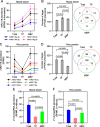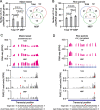Widespread occurrence of microRNA-mediated target cleavage on membrane-bound polysomes
- PMID: 33402203
- PMCID: PMC7784310
- DOI: 10.1186/s13059-020-02242-6
Widespread occurrence of microRNA-mediated target cleavage on membrane-bound polysomes
Abstract
Background: Small RNAs (sRNAs) including microRNAs (miRNAs) and small interfering RNAs (siRNAs) serve as core players in gene silencing at transcriptional and post-transcriptional levels in plants, but their subcellular localization has not yet been well studied, thus limiting our mechanistic understanding of sRNA action.
Results: We investigate the cytoplasmic partitioning of sRNAs and their targets globally in maize (Zea mays, inbred line "B73") and rice (Oryza sativa, cv. "Nipponbare") by high-throughput sequencing of polysome-associated sRNAs and 3' cleavage fragments, and find that both miRNAs and a subset of 21-nucleotide (nt)/22-nt siRNAs are enriched on membrane-bound polysomes (MBPs) relative to total polysomes (TPs) across different tissues. Most of the siRNAs are generated from transposable elements (TEs), and retrotransposons positively contributed to MBP overaccumulation of 22-nt TE-derived siRNAs (TE-siRNAs) as opposed to DNA transposons. Widespread occurrence of miRNA-mediated target cleavage is observed on MBPs, and a large proportion of these cleavage events are MBP-unique. Reproductive 21PHAS (21-nt phasiRNA-generating) and 24PHAS (24-nt phasiRNA-generating) precursors, which were commonly considered as noncoding RNAs, are bound by polysomes, and high-frequency cleavage of 21PHAS precursors by miR2118 and 24PHAS precursors by miR2275 is further detected on MBPs. Reproductive 21-nt phasiRNAs are enriched on MBPs as opposed to TPs, whereas 24-nt phasiRNAs are nearly completely devoid of polysome occupancy.
Conclusions: MBP overaccumulation is a conserved pattern for cytoplasmic partitioning of sRNAs, and endoplasmic reticulum (ER)-bound ribosomes function as an independent regulatory layer for miRNA-induced gene silencing and reproductive phasiRNA biosynthesis in maize and rice.
Keywords: Membrane-bound polysome; Oryza sativa; PARE; Target cleavage; Zea mays; miRNA; phasiRNA; siRNA.
Conflict of interest statement
The authors declare that they have no competing interests.
Figures








Similar articles
-
Biogenesis of phased siRNAs on membrane-bound polysomes in Arabidopsis.Elife. 2016 Dec 12;5:e22750. doi: 10.7554/eLife.22750. Elife. 2016. PMID: 27938667 Free PMC article.
-
Identification of miRNAs and their target genes in developing maize ears by combined small RNA and degradome sequencing.BMC Genomics. 2014 Jan 14;15:25. doi: 10.1186/1471-2164-15-25. BMC Genomics. 2014. PMID: 24422852 Free PMC article.
-
Cis-directed cleavage and nonstoichiometric abundances of 21-nucleotide reproductive phased small interfering RNAs in grasses.New Phytol. 2018 Nov;220(3):865-877. doi: 10.1111/nph.15181. Epub 2018 Apr 30. New Phytol. 2018. PMID: 29708601
-
Biogenesis of diverse plant phasiRNAs involves an miRNA-trigger and Dicer-processing.J Plant Res. 2017 Jan;130(1):17-23. doi: 10.1007/s10265-016-0878-0. Epub 2016 Nov 29. J Plant Res. 2017. PMID: 27900550 Free PMC article. Review.
-
Spatiotemporal regulation and roles of reproductive phasiRNAs in plants.Genes Genet Syst. 2022 Feb 23;96(5):209-215. doi: 10.1266/ggs.21-00042. Epub 2021 Nov 11. Genes Genet Syst. 2022. PMID: 34759068 Review.
Cited by
-
The master role of siRNAs in plant immunity.Mol Plant Pathol. 2022 Oct;23(10):1565-1574. doi: 10.1111/mpp.13250. Epub 2022 Jul 22. Mol Plant Pathol. 2022. PMID: 35869407 Free PMC article. Review.
-
TRANS-ACTING SIRNA3-derived short interfering RNAs confer cleavage of mRNAs in rice.Plant Physiol. 2022 Jan 20;188(1):347-362. doi: 10.1093/plphys/kiab452. Plant Physiol. 2022. PMID: 34599593 Free PMC article.
-
A novel and ubiquitous miRNA-involved regulatory module ensures precise phosphorylation of RNA polymerase II and proper transcription.PLoS Pathog. 2024 Apr 19;20(4):e1012138. doi: 10.1371/journal.ppat.1012138. eCollection 2024 Apr. PLoS Pathog. 2024. PMID: 38640110 Free PMC article.
-
MicroRNA Zma-miR528 Versatile Regulation on Target mRNAs during Maize Somatic Embryogenesis.Int J Mol Sci. 2021 May 18;22(10):5310. doi: 10.3390/ijms22105310. Int J Mol Sci. 2021. PMID: 34069987 Free PMC article.
-
Plant microRNA maturation and function.Nat Rev Mol Cell Biol. 2025 Jul 18. doi: 10.1038/s41580-025-00871-y. Online ahead of print. Nat Rev Mol Cell Biol. 2025. PMID: 40681920 Review.
References
Publication types
MeSH terms
Substances
LinkOut - more resources
Full Text Sources
Other Literature Sources
Research Materials
Miscellaneous

